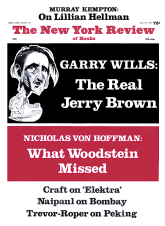This is a disappointing book, particularly since it has been so long awaited. But it tells us more about the great playwright’s life—in details, at least—than any previous attempt. Here we learn the last word on a number of matters: that Chekhov effectively used “nerve-warfare” to prevent his beloved sister from marrying a particular suitor; that literature was his “mistress” and the practice of medicine his “legal wife”—an arrangement that kept him tantalizingly industrious but also fretful and morose; that he had no great interest in women and may even have been, as Hingley gingerly puts it, “somewhat undersexed”; that his marriage to a spiritedly neurotic actress in the last years of his life—he died at forty-four—was frequently interrupted, either by his illness or her career; that he mysteriously kept refusing to acknowledge his own tuberculosis; that he was “unreliable” in meeting literary deadlines; that he was kind, wise, and endlessly elusive, indeed at times “evasive to the point of causing unnecessary suffering.” And so on.
Hingley minutely covers the genesis and flowering of all the plays and many of the short stories and letters. But the style of his writing—both flaccid and jaunty—is tiresome. The critical judgments are venturesomely banal (“In countless variations, both fictional and dramatic, he studies illusions destined sooner or later to be shattered against the trivialities of everyday life”), and the psychological probings, full of self-congratulatory assumptions about Chekhov’s motivations, unconsciously resemble, at times, Nabokov’s parody of the “scholar” who writes the bogus preface to Lolita. Still, this is an exhaustive appraisal by a renowned Chekhov specialist, and every nook and cranny of Chekhov’s existence are in its pages.
In 1911 Roger Casement, a Protestant Irishman in the British Consular Service, was knighted by the Crown for his work in exposing racist atrocities in the Belgian Congo and the Amazon. Five years later he was hanged as a traitor for a quixotic attempt to land German arms in Ireland in conjunction with the 1916 Rising. It has taken sixty years for a biographer to rescue him from English calumnies and Irish canonization. Brian Inglis’s Roger Casement (1974) was the first serious effort to that end; Inglis achieved clinical objectivity in his account, but the inner mystery of the man eluded him. Reid has done something more: he has made sympathetic sense out of a life which was fragmented to the point of “disastrous incoherence.”
Reid thinks that Joseph Conrad, who knew Casement in Africa, understood him when he wrote: “I judged that he was a man, properly speaking, of no mind at all. I don’t mean stupid. I mean he was all emotion.” But Conrad missed Casement’s “Pauline conversion” to Irish nationalism and his increasingly “ritual or somnambular” allegiance to Britain. When Casement left Germany for the abortive arms landing, he said, “I am already a dead man.” He wanted desperately to stop the Rising, which he was convinced would fail. It was the final irony in a life filled with ironies and poised on a psychological abyss, a life held together only by courage.
Reid agrees with Inglis that the Casement diaries—which the English circulated and the Irish denounced—are authentic. They show Casement the furtive, compulsive homosexual; but they are also “tiresome as a fact and as a problem.” Reid’s Casement is “a lesser Hamlet,” inept and self-deceiving, but genuinely noble—“a divided spirit pursuing wholeness.”
“There is something irresistibly human about an Adélie penguin hurrying along an Antarctic beach,” remarks the distinguished paleontologist George Gaylord Simpson. While a well-known expert on fossil mammals, he nevertheless confesses to having been an ardent penguin-watcher for many years. He is fascinated by their variety (some six genera and eighteen species), their range—from Antarctica to as far north as Galapagos, New Zealand, or the African coast—and, of course, their unique adaptations for living. In a scholarly if sometimes leisurely manner, he records the first European sightings of the birds, examines the fossil record, and describes details of anatomy and behavior. Penguins actually fly under water. using their wings as flippers and their feet as rudders. They are so well adapted to cold they have trouble handling warmth. They cannily navigate (even when the sun is not visible) to the site of their birth or former breeding ground. They recognize one another by voice rather than sight. Simpson has much to say about their varied life cycles, “marriage and divorce” rates, their rearing of children, and predators. The chapters on early human encounters and general penguin characteristics are particularly pleasing; those on taxonomy, species differences, or evolutionary origins are more technical, but they usefully introduce the student to the general methods of modern paleontology by focusing on one successful order rather than trying to encompass the entire field of evolution.
Advertisement
This book shows how the financial pyramid supporting the greatest city in the world suddenly crumbled. In the first place, according to Ferretti, it wasn’t sudden. He explains in clear nontechnical language the disastrous budgetary fakery—dating back to Robert Wagner and magnified by John Lindsay—which finally collapsed on the head of pathetic A be Beame. Every year for more than a decade the budget was “balanced” with mirrors—short-term loans floated against speculative future revenues.
It’s a dismal story, in which nearly everyone who held power was culpable: mayors, controllers, budget directors, governors, the municipal unions. To say nothing of William Simon, chief spokesman for the “punitive” approach to New York’s financial troubles and also, during his tenure on Lindsay’s financial advisory board, a great advocate of those same calamitous shortterm borrowing policies.
Ferretti tells what happened month by month between November 1974 and November 1975. He pins Beame’s loss of credibility and the resultant cynicism of investors on the spurious “layoffs” repeatedly announced but somehow never implemented until the advent of Big Mac and the Emergency Control Board. Those agencies, as Ferretti argues, now have the city and its mayor in their grasp. He does not blame New York’s welfare rolls, municipal hospitals, or tuitionfree universities, but believes “they should have been applauded.” He blames cynical pols, “funny bookkeeping,” the banks—which did well out of the city’s troubles. And he says flatly that the fate of New York was actually “legalized default,” with the people, as usual, the losers.
Two years of research in the Kennedy Library and more than 150 interviews—many of them excerpted here—yield a singularly close and fascinating account of JFK from his prep-school graduation to his congressional debut. In disengaging the man from myth, the authors concentrate on Kennedy’s health, his women, and his naval career. An elaborate reconstruction of the .PT-109 episode leads to the conclusion that Kennedy performed some heroic acts and some rash ones, and—like the crew—felt himself disgraced by the loss of the boat. The PT legend was largely the creation of a New Yorker piece by John Hersey (who had married one of Kennedy’s former girl-friends). There was a long affair with Inga Arvad, a columnist and suspected Nazi spy, which probably drew FBI attention during Kennedy’s naval intelligence stint and may have landed in Hoover’s presidential blackmail files.
Emotional reserve and a liking for movie-and-milkshake dates marked Kennedy’s many other liaisons with beautiful and witty women. “His health,” the Blairs argue, “almost from birth, was disastrously poor”; and in 1947—after a vigorous freshman year in Congress—he was diagnosed as having Addison’s disease. Since the disease at the time was often fatal, the ambitious Kennedy family covered up the diagnosis; but the authors attribute JFK’s subsequent absenteeism and lackluster performance in the House to this circumstance. Whatever the accuracy of the authors’ interpretations of the evidence, they give a rich sense of the mixture of shyness, sensitivity, and callousness that characterized Kennedy; his deliberate use of what he called his “BP”—Big Personality; and the disabilities of having a spectacularly amoral father. A book surprisingly free of malice or prurience.
This Issue
June 10, 1976



